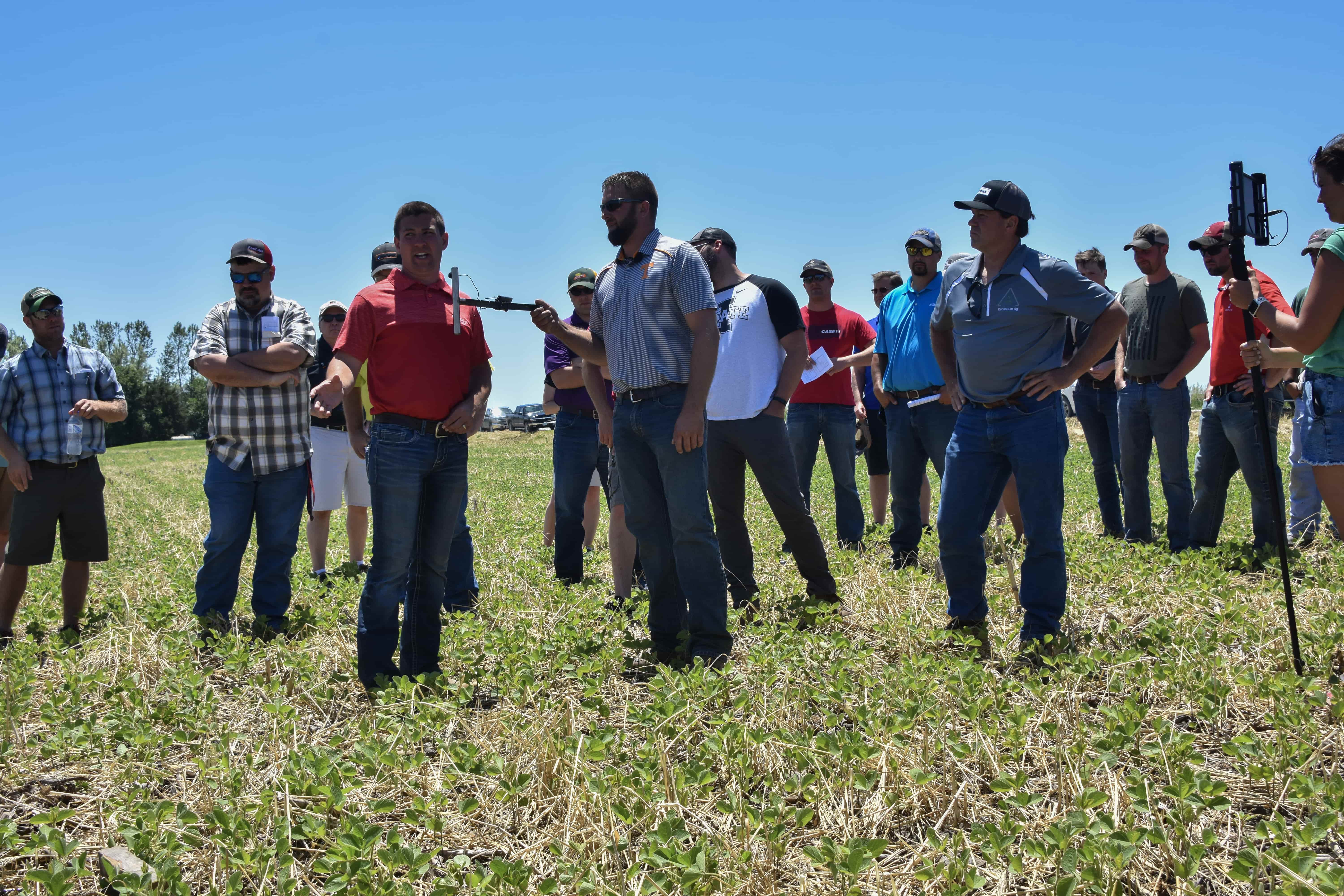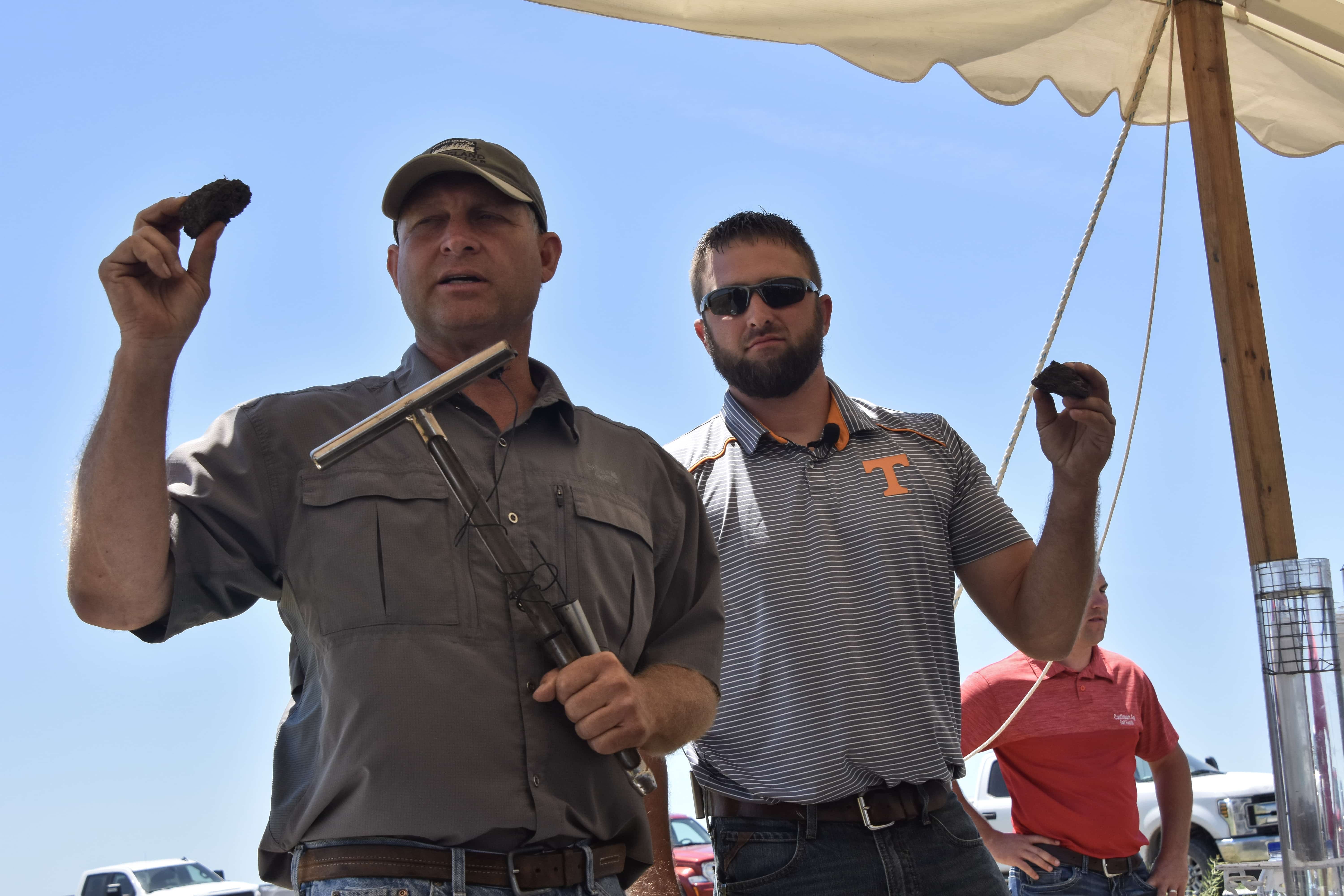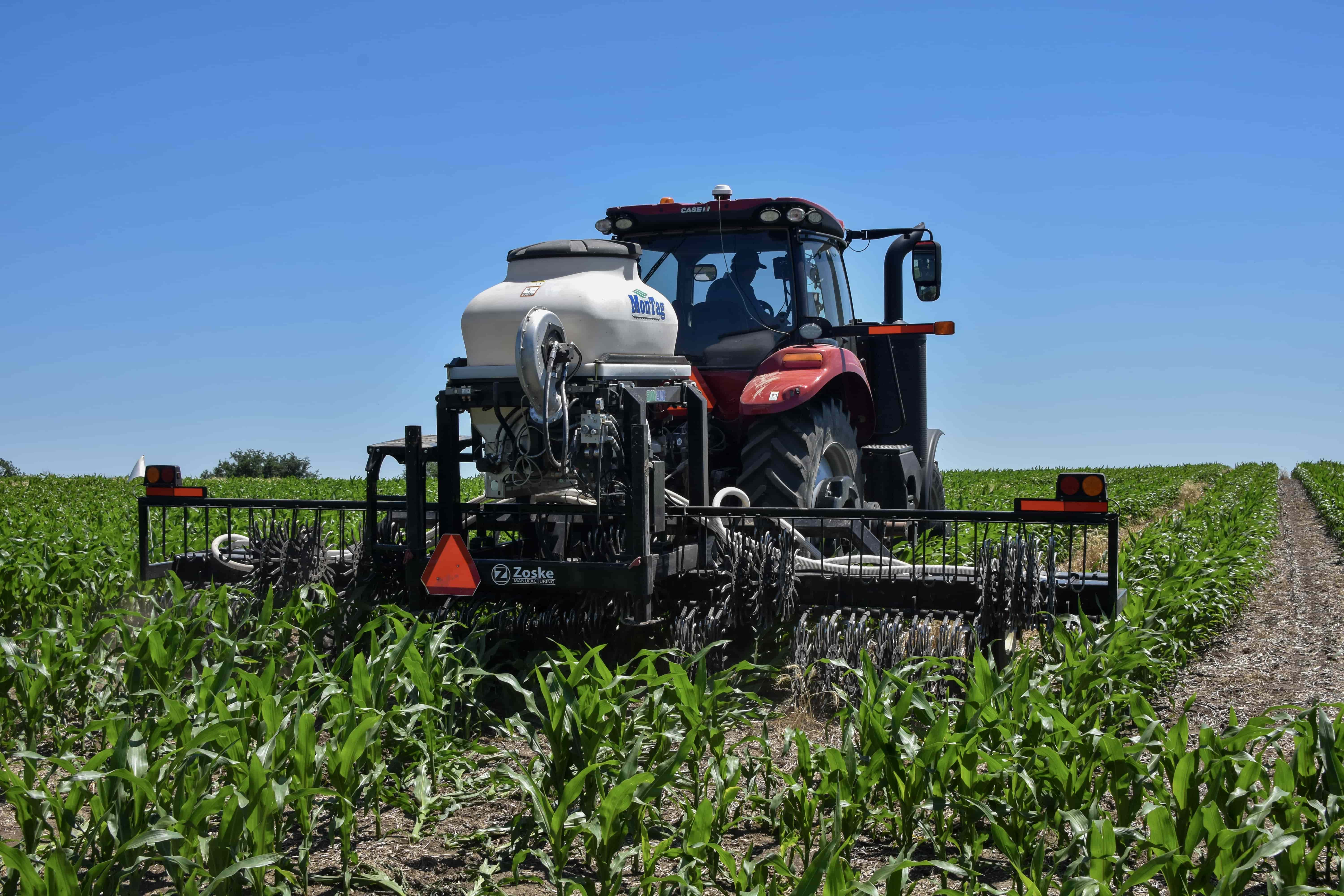By Kurt Lawton
Despite Covid-19 and hot weather, an impressive turnout — more than 150 farmers and other soil-loving attendees — gathered at the Hora family farm in southeast Iowa to experience hands-on soil health demos, cover crop experiments, and creative cropping systems.
Continuum Ag founder and soil health consultant Mitchell Hora (shown above in middle of photo, wearing a red polo shirt) showcased the farm’s numerous creative uses of cover crops, relay crops, 60-inch corn, and interseeding demos of cover crops. The goal was to help farmers think beyond the usual 30-inch row corn and soybean system.
Farm profit through diversity
“The diversity component was a big part of the field day — from interseeding corn with multi-species cover crops in June, to growing a relay crop of rye with soybeans,” Hora says. “We’re proving these farm changes to ourselves, on our farm, while showing others that different profit opportunities exist if we add diversity, get more creative and implement the principles of soil health.”
Mitchell, his dad, Brian, and their family opened up their 700-acre farm to attendees and online Facebook Live viewers to demonstrate soil regeneration, research trials, and agronomic practices that drive higher profitability.

“In fact,” Mitchell added, “our soybean and wheat relay crop was more profitable than any of our corn and soybean crops last year.”
With shovel and water bottle in hand, NRCS Regional Soil Health Specialist Doug Peterson demonstrated two natural methods to determine improving soil health—soil structure and water infiltration.
Keeping valuable rainfall in the field
After only three years of cover crops following corn and soybeans in Mitchell’s 40-acre field, the soil infiltration rate test showed the first inch of simulated rainfall was absorbed in 24 seconds, and the second inch took 2.5 minutes. Last year, the same field recorded 2 minutes for the first inch and 14 minutes for the second. “One of the biggest takeaways from the field day was the infiltration test result in our relay crop field, which absorbed 4 inches of simulated rain in less than 5 minutes, which is amazing,” Mitchell says.
These numbers indicate a vast improvement in soil aggregate stability, especially considering this field had received a three-inch rain event just seven days before the field day. Farms with poor aggregate stability are vulnerable to as much as 50 to 80% of rain run off, causing erosion and nutrient loss.

There is a significant need to restore and rebuild soil organic matter and aggregate stability inadvertently degraded with tillage, Peterson adds. “We accomplish that using the soil health principles: minimize soil disturbance, maximize soil cover, maximize biodiversity of crops, grow continuous living roots, and integrate livestock.”
On the 90-degree field day, Peterson used several thermometers to show the importance of keeping soil covered with cover crops and crop residue. Bare soil temperature was 103 degrees on the surface and 81 degrees at two-inch depth — compared to 71 degrees at two-inch depth when covered by residue.
“The soil critters responsible for improving soil biology are most active and efficient at 75 degrees with adequate moisture, proving that this soil armor is protecting soil health, especially on hot days,” Peterson says.
Peterson and the Hora family exude passion when they talk about conservation and soil health. Mitchell is the seventh generation on this nearly 150-year-old family farm, working with his dad to carry on their conservation legacy. Brian is a firm believer in no-till, halting erosion and improving water quality, as well as conducting on-farm research to continually find efficiencies.
Mitchell’s love of soil regeneration and data led to his launch of Continuum Ag in 2015, during his junior year at Iowa State University. He helps farmers take a holistic fertility approach using soil analysis based on physical, chemical, and biological properties to provide recommendations for lime, phosphorus, potassium, nitrogen, and micronutrients.
Seeding cover crops in June
The Hora’s have experimented with 60-inch corn for several years. They are happy with the yields being comparable to their 30-inch corn, but work continues on a cover crop mix or application method that can keep weeds down in the gap to reduce herbicide costs. “This farm has some weed issues, as we’ve only had it three years, so we’re experimenting with optimum timing,” Brian says.
“With 30-inch rows, we need to apply cover crops around V3 to V5-6, so we get good growth but not compete with the crop,” he says. “With a 60-inch gap, we’ve got more time to apply and can wait for rains to improve emergence.”
This year, they’re trying some June cover crop interseeding in-between the corn rows. Mitchell is using a diverse cover crop mix of brassicas, grasses, and some legumes, with the goal of these covers providing enough nutrients to feed his 2022 corn crop.
The field day showcased two different application trials, one spread by a Rantizo drone, and the other using a Montag seeder mounted on a rotary hoe.
The Rantizo octocopter drone featured a 45 lb. payload capacity and a 14-ft. boom to spread a cover crop mixture in a 20 ft. swath width, says Michael Ott, CEO of the Iowa City-based company. The liquid sprayer then flew five feet above the crop to deliver inside the canopy coverage. It is capable of autonomous flight and autonomous loading for map-based precision spraying.
The Montag 2108 Gen II fertilizer applicator, attached to a Zoske rotary hoe, demonstrated another method to get cover crops seeded in a growing corn crop.

“We are traveling around the Midwest to apply cover crops with this rig, as more farmers are interested in the potential to get earlier growth to deliver higher biomass following harvest,” says Mark Seipel with Montag Manufacturing. “By running at higher speeds with a rotary hoe, we’re lifting residue and scratching the soil to get cover crops through the residue to aid germination.”
Mitchell is pleased so far with the results of the cover crop growth using the rotary hoe, adding, “If I had two boxes, I’d be spreading urea with the cover crops, too.”
Relay crops and two harvests
In another field by the home place near Ainsworth, the Horas are working with the Iowa Soybean Association (ISA) and Northeast Iowa Resource Conservation and Development on relay crop trials. Last year they used wheat, and this year rye is growing with soybeans. Drilling the small grains as a winter cover/seed crop followed in spring by drilled soybeans allows for two separate harvests and profits from two crop.
Theo Gunther, Program Development Coordinator for the ISA Research Center for Farming Innovation, says this system can protect and improve soil and water quality in early spring by allowing full small grain growth to capture and recycle nutrients. “In 2019, fields where we didn’t see cover crop growth, we didn’t see water quality benefits in tile water samples,” says Theo.
The Horas harvested the rye grain heads sticking above the soybean canopy on July 10th, using their existing combine and bean head. They save the grain to seed as a cover crop in the fall or spring.
ISA has six relay crop trials in Iowa to learn more about crop timing, seeding methods, weed and disease management, small grain varieties, and crop yields. “We know two crops on the same acre works. Preliminary data from 2019 showed a profit range from $95 to $212 per acre with relay crops,” says Theo. “Early small grain growth saved money on pre-emerge herbicides. The relay soybeans can get close to normal yields, which we hope our side-by-side replicated trials will prove.”
Growing mustard and barley in Iowa?
“What?!” That was Mitchell’s repeated response during a cold call from a California seedsman seeking possible Midwest-grown mustard seed, as their foreign supply was drying up due to Covid-19 supply chain disruptions.
After a lot of research, including sourcing bees for pollination, the Horas are trying 17 acres of mustard this year. “While I’m still pretty skeptical, I’m getting paid well during the season, so we’ll see how it goes,” Mitchell says.
Their other foray into specialty crops involves growing a different small grain, high-quality barley for a local malt processor that sells to craft breweries in Iowa. “It’s another fun venture, and another crop that adds diversity toward improving our soil health, and improving our revenue beyond corn and soybeans,” Mitchell adds.
Mitchell and Brian are also doing multiple-year research trials with various biological products and foliar micronutrients to find ways to boost plant and soil health.
Supply chain panel discusses consumer, farmer benefits
To conclude the field day — sponsored by ISA On-Farm Network, Iowa Corn and PhytoBiotics —the Hora’s hosted an online supply chain discussion about finding sustainable economic value streams for farmers and how to communicate such farming values to consumers.
Participants included Minnesota farmer Zach Johnson (co-host of America Public Media’s FieldWork podcast with Mitchell); USDA soil scientist Rick Haney; ISA Director of Conservation and External Programs Adam Kiel; Cargill’s Global Row Crop Sustainability Director Ryan Sirolli; and OCP North America sustainability lead Krista Maruca.
Key takeaways for farmers:
· Consumers want greater transparency from farmers and the supply chain about their food. Farmers want financial value for the attributes and data they deliver.
· Consumer-facing companies are developing better, more sustainable products for consumers and are willing to partner with farmers who can quantify data for product and environmental outcomes (to satisfy consumer desires of carbon sequestered, water quality, water use efficiency, and nutrient density).
· Farmers can participate in this sustainable supply chain with higher quality soil (better testing) that will deliver more nutrient-dense specialty crops, while proving water quality, carbon sequestration, and reduced GHG emissions.
· Fertilizer and other input companies must innovate to provide more efficient and targeted products that help farmers meet food and environmental goals.
· ISA and Quantified Ventures seek to pay more farmers to participate in their Soil & Water Outcomes Fund project for 2021. Farmers who adopt a better system that helps sequester carbon and improves water quality will receive acreage payments ($30-$50/acre in 2020). Outcomes are independently measured and sold by the Fund to beneficiaries like water and wastewater facilities, corporations with supply chain sustainability targets, conservation organizations, and more.
Mitchell wrapped up the day with the hope that these discussions continue, and that the supply chain opens up additonal revenue streams for farmers, all to incentivize conservation that can achieve greater holistic farm management.
“Our goal with the field trials is to show farmers how they can implement the principles of soil health while applying more creativity beyond a corn-soybean system,” he says. “Start slowly on a small area of a farm, then apply what works on a larger scale.”
